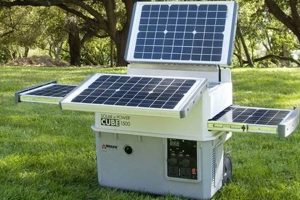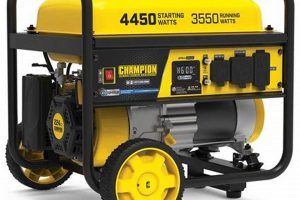A compact, mobile power source capable of supplying electricity to an entire residential building offers a crucial backup solution during outages caused by severe weather, grid failures, or other disruptions. This independent electricity generation provides uninterrupted power for essential appliances like refrigerators, HVAC systems, lighting, and medical equipment, maintaining comfort and safety.
Maintaining access to electricity is vital for modern life. This type of backup power ensures continuity of essential services, safeguarding health, preserving food, and enabling communication. Historically, homes relied on less convenient and efficient methods for backup power. The development and refinement of these compact, powerful generators represent a significant advancement in residential power solutions, offering a more practical approach to emergency preparedness and grid independence.
Further exploration will cover selecting the correct unit size, understanding various fuel types and their associated costs, safe operation procedures, proper connection methods, and ongoing maintenance requirements.
Tips for Whole-House Generator Use
Effective use of a backup power source for a residence requires careful planning and execution. The following tips provide guidance for safe and efficient operation.
Tip 1: Accurate Power Assessment: Calculate the total wattage required to run essential appliances and systems. This assessment should include starting wattage, which is often significantly higher than running wattage.
Tip 2: Professional Installation: Engage a qualified electrician for proper installation, including a transfer switch, which safely disconnects the house from the utility grid during generator operation. Incorrect installation can damage appliances and pose significant safety risks.
Tip 3: Proper Fuel Management: Understand the chosen fuel type (gasoline, propane, diesel) and ensure adequate storage in approved containers. Monitor fuel levels regularly and adhere to safe refueling practices.
Tip 4: Routine Maintenance: Regular maintenance, including oil changes, air filter replacements, and spark plug inspections, ensures optimal performance and extends the generator’s lifespan.
Tip 5: Safe Operation: Always operate the unit outdoors in a well-ventilated area, away from doors, windows, and flammable materials. Carbon monoxide poisoning is a serious risk.
Tip 6: Load Management: Avoid overloading the generator by staggering the use of high-wattage appliances. Prioritize essential equipment during outages.
Tip 7: Adherence to Local Regulations: Comply with all local ordinances regarding generator use, including noise restrictions and permitting requirements.
By following these guidelines, homeowners can ensure reliable backup power during emergencies while maximizing safety and the longevity of their investment.
Careful planning and proactive maintenance are essential for successful whole-house generator operation.
1. Power Output (Wattage)
Power output, measured in watts, represents a critical factor when selecting a portable generator intended for whole-house use. This metric directly determines the number and types of appliances and systems the generator can operate simultaneously. Understanding wattage requirements for various household devices is crucial for effective generator sizing. For example, a refrigerator might require 700 starting watts and 200 running watts, while a central air conditioning unit could demand considerably more. Underestimating wattage needs can lead to overloaded circuits, generator damage, and insufficient power during outages.
Calculating total wattage demand involves summing the running watts of all intended appliances. Crucially, starting wattage, often significantly higher than running wattage, must be considered for appliances with electric motors, such as refrigerators and air conditioners. Failing to account for these surge demands can cause the generator to stall when these appliances cycle on. Accurately assessing total wattage needs ensures uninterrupted operation of essential systems during power disruptions.
Selecting a generator with adequate wattage is paramount for reliable whole-house power. Insufficient power can compromise safety and comfort during extended outages. A thorough wattage assessment, considering both running and starting demands, facilitates informed generator selection and dependable performance when needed most.
2. Fuel Type
Fuel type significantly influences the practicality and cost-effectiveness of a portable generator intended for whole-house power supply. The choice of fuel impacts generator runtime, storage requirements, availability, and environmental considerations. Careful evaluation of these factors is essential for selecting the most suitable fuel type for individual needs and circumstances.
- Gasoline
Gasoline offers widespread availability and generally lower upfront generator costs. However, gasoline has a limited shelf life, requiring fuel stabilizer use and periodic replacement. Its volatility poses storage challenges and flammability risks. Gasoline-powered generators are generally suitable for shorter outages due to these storage limitations.
- Propane
Propane provides a longer shelf life than gasoline, simplifying storage and reducing fuel degradation concerns. Propane-powered generators often offer cleaner emissions. However, propane requires larger, specialized tanks, which can be more expensive and less readily available than gasoline. Propane’s longer runtime makes it well-suited for extended power outages.
- Diesel
Diesel generators offer exceptional efficiency and long runtimes. Diesel fuel is less flammable than gasoline, reducing storage risks. However, diesel generators tend to be more expensive initially and require more extensive maintenance. Diesel is often preferred for prolonged or frequent power outages due to its efficiency and runtime.
- Natural Gas
Natural gas generators offer the convenience of a continuous fuel supply when connected to a residential natural gas line, eliminating refueling needs. They produce relatively clean emissions. However, installation requires professional connection to the gas line, increasing initial expenses. Natural gas generators are ideal for locations with reliable natural gas service and frequent outage susceptibility.
The optimal fuel type for a whole-house portable generator depends on individual circumstances, including outage frequency and duration, budget, storage capacity, and access to fuel supplies. Balancing these factors ensures reliable and cost-effective backup power during grid disruptions.
3. Runtime
Runtime represents a crucial factor in selecting a portable generator for whole-house power, directly impacting the duration of uninterrupted operation during a power outage. Runtime, typically measured in hours, depends on fuel capacity and the generator’s load. A generator with a larger fuel tank and lower power consumption will generally provide a longer runtime. This duration is critical for maintaining essential services, especially during extended grid disruptions. For instance, a family relying on electrically powered medical equipment requires a generator with sufficient runtime to cover the entire outage duration. Similarly, preserving refrigerated or frozen food during a prolonged power failure necessitates a generator capable of sustained operation. Understanding runtime requirements is essential for effective generator selection and preparedness.
Several variables influence generator runtime. The load, representing the total wattage consumed by connected appliances, directly affects runtime. Higher power consumption reduces the operational duration. Ambient temperature can also influence runtime, with higher temperatures potentially decreasing efficiency. Fuel type plays a significant role, with diesel and propane generally offering longer runtimes than gasoline. Regular maintenance, including clean air filters and fresh oil, can optimize fuel efficiency and extend runtime. Calculating estimated runtime based on anticipated load and fuel capacity allows for informed generator selection to meet specific power needs.
Selecting a generator with adequate runtime ensures sufficient power for the duration of anticipated outages. Underestimating runtime requirements can lead to power interruptions, jeopardizing safety and comfort. A thorough assessment of power needs, considering both the duration and frequency of typical outages, facilitates informed decision-making. Prioritizing essential appliances and managing power consumption during outages can further extend the effective runtime, maximizing the generator’s utility in maintaining essential services.
4. Portability
Portability, a defining characteristic of these generators, significantly impacts their practicality for whole-house power supply. This characteristic facilitates convenient transport and storage, crucial for both routine maintenance and deployment during emergencies. Unlike permanently installed standby generators, portable units can be readily moved to the optimal location for operation, maximizing safety and efficiency. This mobility is particularly advantageous for users who may need to relocate the generator for various reasons, such as accommodating changing weather conditions or sharing the generator with others. For example, a homeowner might store the generator in a garage during fair weather and then move it to a covered patio for operation during a storm, ensuring safe operation away from windows and doors while minimizing noise disruption. This flexibility underscores the practical value of portability in emergency preparedness.
The weight and size of a portable generator directly affect its maneuverability. Smaller, lighter units are easier to transport and position, while larger, heavier models may require assistance or specialized equipment for movement. Features such as integrated wheels and handles enhance portability, simplifying relocation. The physical dimensions of the generator also influence storage requirements. Compact designs minimize storage space demands, making them practical for users with limited storage capacity. Evaluating portability based on weight, size, and integrated mobility features ensures practical handling and storage, maximizing the generator’s accessibility and usability when power is needed.
Portability, while essential for convenient handling and storage, requires consideration alongside power output and runtime. Balancing portability with power requirements involves assessing the necessary wattage to operate essential appliances and the desired duration of operation. Selecting a generator that is both portable and powerful enough to meet household needs ensures a practical and effective backup power solution. A lighter, more portable generator might be suitable for powering essential appliances during short outages, while a larger, less portable unit might be necessary for extended outages or powering multiple high-wattage devices. Understanding the interplay between portability and power requirements facilitates informed generator selection, balancing ease of use with the necessary power output for sustained operation.
5. Safety Features
Safety features are paramount for portable generators intended to power a whole house, mitigating inherent risks associated with electricity generation and fuel combustion. These features safeguard users, connected appliances, and the residence itself. A critical safety component is the automatic shutoff system, which activates in response to low oil levels, preventing engine damage and potential fire hazards. Overload protection prevents excessive current draw, protecting connected appliances from damage and reducing the risk of electrical fires. Carbon monoxide (CO) detection and shutoff features are essential for preventing CO poisoning, a colorless, odorless, and potentially fatal gas produced during fuel combustion. This feature automatically shuts down the generator if unsafe CO levels are detected, protecting occupants from exposure.
Real-world scenarios highlight the importance of these safety features. Consider a homeowner utilizing a portable generator during a power outage. A drop in oil pressure, undetected without an automatic shutoff, could lead to catastrophic engine failure and potential fire. Similarly, if a surge in power demand occurs, exceeding the generator’s capacity, overload protection prevents damage to sensitive electronics and appliances. In a situation where the generator is inadvertently placed too close to a window or door, the CO detection system activates, averting potential CO buildup and protecting inhabitants from harm. These examples underscore the critical role safety features play in preventing accidents and mitigating risks.
Understanding the function and importance of safety features is essential for safe generator operation. Regularly inspecting and testing these features ensures proper functionality. Adhering to manufacturer guidelines regarding placement, operation, and maintenance further enhances safety. A proactive approach to safety, coupled with a thorough understanding of generator operation, mitigates risks, protects lives and property, and ensures reliable power during outages. Neglecting safety precautions can have dire consequences, underscoring the critical role these features play in responsible generator ownership and operation.
Frequently Asked Questions
This section addresses common inquiries regarding the selection, installation, and operation of portable generators for whole-house power supply. Clear and concise answers provide essential information for informed decision-making.
Question 1: What size portable generator is needed to power an entire house?
Generator sizing depends on the specific wattage requirements of the home. A thorough assessment of essential appliances and their respective running and starting wattages is crucial. Consulting a qualified electrician is recommended for accurate load calculations and generator sizing.
Question 2: Is professional installation required for a portable generator used for whole-house power?
Professional installation, particularly involving a transfer switch, is strongly recommended. A transfer switch safely disconnects the house from the utility grid during generator operation, preventing backfeeding and protecting utility workers. Incorrect installation can be hazardous.
Question 3: What are the primary fuel options for portable generators, and what are their respective advantages and disadvantages?
Common fuel types include gasoline, propane, diesel, and natural gas. Gasoline offers wide availability but limited shelf life. Propane provides extended storage but requires larger tanks. Diesel offers efficiency and long runtimes but higher initial costs. Natural gas provides continuous fuel supply but necessitates professional connection.
Question 4: How long can a portable generator typically power a house during an outage?
Runtime depends on fuel capacity, generator load, and efficiency. Larger fuel tanks and lower power consumption extend runtime. Calculating anticipated load and consulting manufacturer specifications provides estimated runtime figures.
Question 5: What safety precautions are essential when operating a portable generator?
Operate generators outdoors in well-ventilated areas away from flammable materials. Never operate a generator indoors. Ensure proper grounding. Regularly inspect and test safety features such as automatic shutoff and carbon monoxide detection.
Question 6: What maintenance is required for a portable generator to ensure reliable performance?
Regular maintenance, including oil changes, air filter replacements, and spark plug inspections, is crucial for optimal performance and longevity. Consult the manufacturer’s recommendations for specific maintenance intervals and procedures.
Careful consideration of these frequently asked questions facilitates informed decisions regarding portable generator selection, installation, and operation. Prioritizing safety and proper maintenance ensures reliable backup power during outages.
The subsequent section will delve into specific generator models and their respective features.
Portable Generators for Whole-House Power
Equipping a residence with a portable generator capable of powering the entire house provides a crucial safeguard against power disruptions. Careful consideration of factors such as power output, fuel type, runtime, portability, and safety features ensures selection of a suitable unit. Professional installation, including a properly configured transfer switch, is essential for safe and reliable operation. Adherence to manufacturer guidelines regarding maintenance and safe operating procedures ensures long-term functionality and mitigates potential risks. Understanding the nuances of generator selection and operation empowers homeowners to make informed decisions regarding backup power solutions.
Reliable access to electricity is paramount in modern life. Investing in a properly sized and maintained portable generator provides peace of mind, ensuring essential services remain operational during unforeseen power outages. Proactive planning and preparation are crucial for mitigating the impact of power disruptions and maintaining a safe and comfortable environment.






